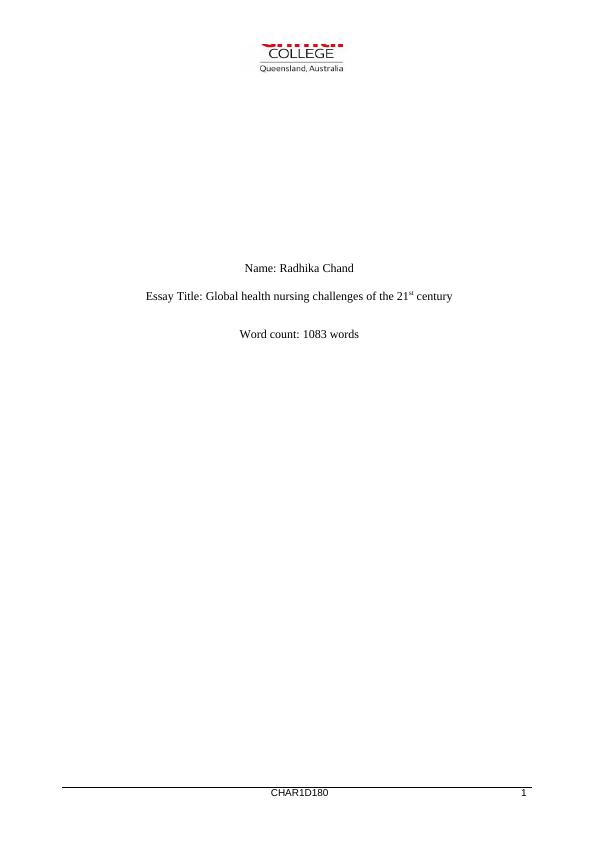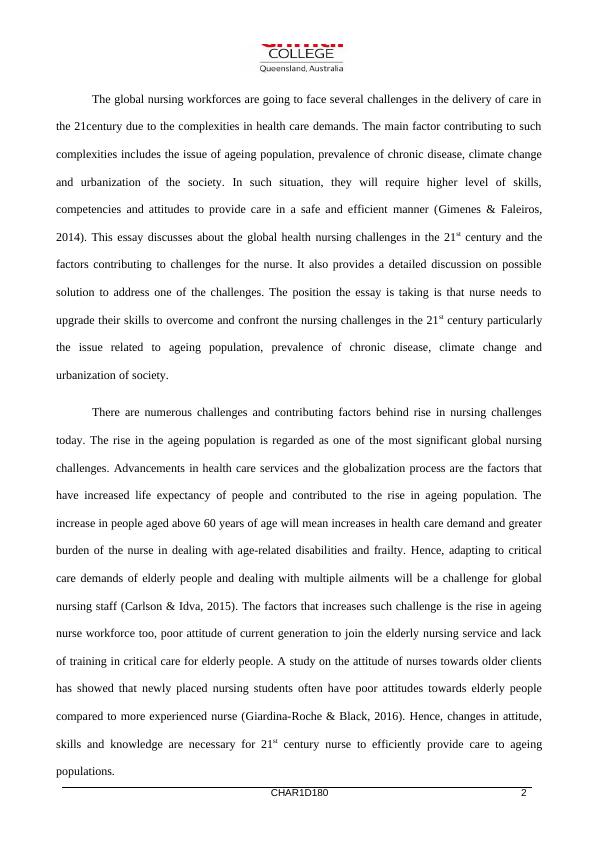The Global Nursing Workforces | Case Study
17 Pages3354 Words19 Views
Added on 2021-04-21
The Global Nursing Workforces | Case Study
Added on 2021-04-21
ShareRelated Documents
CHAR1D18011Name: Radhika ChandEssay Title: Global health nursing challenges of the 21st centuryWord count: 1083 words

CHAR1D18012The global nursing workforces are going to face several challenges in the delivery of care inthe 21century due to the complexities in health care demands. The main factor contributing to suchcomplexities includes the issue of ageing population, prevalence of chronic disease, climate changeand urbanization of the society. In such situation, they will require higher level of skills,competencies and attitudes to provide care in a safe and efficient manner (Gimenes & Faleiros,2014). This essay discusses about the global health nursing challenges in the 21st century and thefactors contributing to challenges for the nurse. It also provides a detailed discussion on possiblesolution to address one of the challenges. The position the essay is taking is that nurse needs toupgrade their skills to overcome and confront the nursing challenges in the 21st century particularlythe issue related to ageing population, prevalence of chronic disease, climate change andurbanization of society.There are numerous challenges and contributing factors behind rise in nursing challengestoday. The rise in the ageing population is regarded as one of the most significant global nursingchallenges. Advancements in health care services and the globalization process are the factors thathave increased life expectancy of people and contributed to the rise in ageing population. Theincrease in people aged above 60 years of age will mean increases in health care demand and greaterburden of the nurse in dealing with age-related disabilities and frailty. Hence, adapting to criticalcare demands of elderly people and dealing with multiple ailments will be a challenge for globalnursing staff (Carlson & Idva, 2015). The factors that increases such challenge is the rise in ageingnurse workforce too, poor attitude of current generation to join the elderly nursing service and lackof training in critical care for elderly people. A study on the attitude of nurses towards older clientshas showed that newly placed nursing students often have poor attitudes towards elderly peoplecompared to more experienced nurse (Giardina-Roche & Black, 2016). Hence, changes in attitude,skills and knowledge are necessary for 21st century nurse to efficiently provide care to ageingpopulations.

CHAR1D18013Another widely recognized global nursing challenge in the current century is the prevalenceand the high incidence of non-communicable disease (NCDs) worldwide. Chronic diseaseparticularly NCDs are the leading cause of mortality and morbidity worldwide. The World HealthOrganization (2015) report mentions that in 2015, about 56 million deaths occurred worldwide and70% of these deaths were caused by NCDSs like cardiovascular disease, cancer, diabetes and lungdisease. As this trend is a threat to the health of populations specially in low and middle incomecountries, the global nursing workforce faces a challenge in integrating evidence based preventionand treatment programs into primary care system. This challenge is further compounded by factorslike shortage of nursing workforce, lack of skills in the management of NCDs and inefficiency intranslating evidence into practice (Hersch, 2015). Hence, the nursing workforce needs to evolve toovercome the primary health care crisis (Smolowitz et al., 2015). Apart from ageing population and prevalence of chronic disease, climate change,urbanization, disparities in health care access and food security related issues will be a major hurdlefor nurses to overcome in the coming years. Climate and environmental issues increases thechallenges nurses face because this issue affects other systems like urbanization, health care accessand food security. Climate change is strongly linked to human health as extreme weather events likenatural disasters affects the availability of food and water, settlement patterns of people andtransmission of vector borne diseases. Vulnerable populations such as children, elderly people,people living in poverty are most likely to be affected by climate changes as they lack resilience andappropriate resources to maintain health and well-being. Hence, for nurses joining the nursingworkforce in the coming years, coping with climate change will be challenging. This is mainly dueto the impact of climate change on various other aspects of human life. Therefore, the issue ofclimate change needs to be critically analysed to determine possible solutions that can prepare theglobal nursing workforce to effectively handle health issues arising due to climate change.

CHAR1D18014Climate change will have a devastating impact on vulnerable groups that were identifiedabove. Hence, for an adequate nursing workforce of the future, action need to be taken to protectvulnerable groups from the harmful consequence of extreme weather events. The nurses must bemade aware of the effects climate change on human health and develop the skills needed to mitigatehealth risks in affected population (AnAaker et al., 2015). The nursing workforce can be encouragedto play a role in sustainable development by empowering groups, communities and individual tocreate a healthy society (Breakey et al., 2015). They should also be involved in health promotionactivities by teaching about behaviours to positively influence environment and be sustainable. Suchkind of strategies to spread nurse’s awareness about their responsible towards and climate andenvironmental issues can pave for transforming the health care sector from unsustainabledevelopment to sustainable development. Inclusion of the topic of sustainability in nursing educationcan also help global nursing workforce to be prepared for future challenges in practice (AnAaker etal., 2015). Due to changes in climate, future nursing workforce will need to handle large number ofdisaster cases. Hence, they can also engage in disaster preparedness by to minimise challenges inhealth delivery in the 21st century. For this, they need to engage in professional developmentprogramme in the area of epidemiology, disaster response and competencies for disaster response.This knowledge can support them in effectively responding to public health epidemics,environmental hazards and protecting vulnerable people from health risk (Rokkas, Cornell &Steenkamp, 2014).In conclusion, challenges for nurse in the 21st century increased due to population ageing,prevalence of NCDs, climate change, food insecurities and health risk in vulnerable population. Inresponse to each challenge, there are many hurdles for nurses in providing care and includesresponding to critical demands of elderly people, coping with health consequences of climate changeand high work burden due to the prevalence of chronic diseases. All these factors contribute to

End of preview
Want to access all the pages? Upload your documents or become a member.
Related Documents
The Rise of NCDs Necessitates a Range of Adjustments by Health Systems in Australialg...
|15
|4241
|144
The 21st Century Global Healthcare Workforcelg...
|3
|2982
|14
Cardiovascular Disease: Global Trends, Prevalence, and Managementlg...
|21
|6253
|76
Health Care Delivery Methods in Dementia and Impact of Povertylg...
|11
|2841
|165
Ibuprofen for Pain Management in Older Peoplelg...
|11
|2613
|255
Physical And Behavioral Scienceslg...
|4
|742
|17
